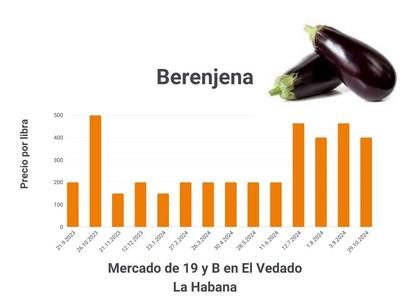In just one year, eggplant, little liked on the Island, has doubled in price

![]() 14ymedio, Natalia López Moya, Havana, 17 November 2024 — A few years ago, eggplant was one of the few crops that did not have to be protected from thieves. While the farmers, with machetes hanging from their belts, guarded the garlic crops, the bananas and the furrows loaded with bean pods, the eggplant, with its smooth purple skin, was not in the sights of the vandals who devastated the plantations on the Island. But that has changed.
14ymedio, Natalia López Moya, Havana, 17 November 2024 — A few years ago, eggplant was one of the few crops that did not have to be protected from thieves. While the farmers, with machetes hanging from their belts, guarded the garlic crops, the bananas and the furrows loaded with bean pods, the eggplant, with its smooth purple skin, was not in the sights of the vandals who devastated the plantations on the Island. But that has changed.
A large fruit, with a firm and soft whitish interior with numerous edible seeds, eggplant can be consumed in many ways. Among Cubans it is mainly roasted, sliced and fried, baked, sautéed or added to a broth. Less known on home tables but increasingly present in the kitchens of private restaurants, when made with cream it serves as an accompaniment in numerous combinations.
“I have a special affection for eggplant but in my house no one eats it, only me,” Damaris, a 48-year-old resident of Marianao, tells 14ymedio. “I spent the hardest years of the Special Period as a pre-university scholarship student in Güira de Melena. Among the local crops was eggplant, and we worked in the fields weeding and harvesting it.”
In the women’s dorm, the students tried to relieve the roar of hunger that came out of their stomachs
In the women’s dorm, the students tried to relieve the roar of hunger that came out of their stomachs. “We made all kinds of preparations with corn, condensed milk and anything that appeared, but as we ran out of ingredients we began to take what we found in the fields so as not to go to bed with empty stomachs.”
Thus was born a dish that Damaris adores: grilled eggplant. “We had one of those old clothes irons that weighs a lot. We cut the eggplant into slices, put them on the top of a locker and ironed them, pressing hard so that they were very golden.” A preparation of “lemon, cilantro and salt” pressed on top with the hot iron made a dish “that tasted like glory.”
Culinary preferences are greatly influenced by memories: the smell of the red bean stew in the corridor of the quarters when returning from school, the funny tentacles of the squid that peeked out on the children’s plate, and that malanga cream that grandmother made by crushing the food with a fork and adding some milk. Memory shapes the palate and defines the dishes that make us salivate.
But millions of Cubans do not share Damaris’s appetizing memory of the eggplant. “My children can’t even look at it and my husband doesn’t like it, so I hardly buy any because they are big, and for one person it’s not worth it. I cut a piece, cook it, and the rest almost always spoils because I’m the only one eating it.” The family of the once-scholarship holder belongs to that majority of Cubans who see this food as “something that tastes like nothing and absorbs a lot of oil, a real food for fools.”

However, not even that generalized impression of the fruit, which has a high percentage of water and a great versatility for combining with other foods, has put the eggplant on the sidelines of inflation. If in September of last year a pound of the product cost 200 Cuban pesos in El Vedado’s 19th and B market, by this November it had already doubled in price.
“It serves to complete a dish, and if it is prepared with enough garlic, onion and lemon it replaces meat, which is so expensive,” said Catalina, an elderly woman who approached the platform of a cart driver in the Cerro neighborhood. “I dip it in a good Creole mojo, bread it and cool it, and my grandchildren ask me where I got the steaks,” the woman says in a mischievous tone. “I also put it on rice, and that’s how I make it stretch.
“A few days ago, a friend taught me how to make eggplant lasagna. It tastes delicious; the problem is that cheese is very expensive. Not to mention that tomato and now eggplant are both more expensive, so it’s not a cheap recipe either.” At least, she says, she has a good oven with the so-called “street” gas, one of the few services that still has some stability in the Cuban capital. Catalina will not have to use an iron to brown each spongy slice of tiny seeds.
Translated by Regina Anavy
____________
COLLABORATE WITH OUR WORK: The 14ymedio team is committed to practicing serious journalism that reflects Cuba’s reality in all its depth. Thank you for joining us on this long journey. We invite you to continue supporting us by becoming a member of 14ymedio now. Together we can continue transforming journalism in Cuba.
